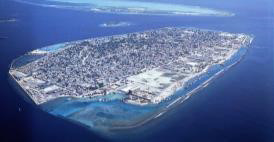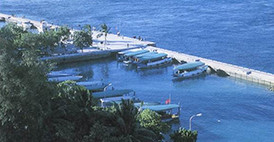Protecting local community from threat of high tide and sea level rise by building resilient infrastructure
TAISEI CORPORATION
Island nations are vulnerable to high tides due to insufficient height above sea level and are at the brink of submersion due to rising sea level associated with global warming. TAISEI CORPORATION builds robust yet eco-friendly seawall in such vulnerable areas. In addition to enhancing disaster preparedness, the Company plays a key role in socioeconomic infrastructure and secure lives and assets of island people. Building robust seawall serves as an adaptation measure in the field of infrastructure.
| Publication date | March 21, 2017 |
|---|---|
| Sector | Natural Disasters / Coastal Areas |
Company Overview

TAISEI CORPORATION was founded in 1873 and established itself as one of five super general contractors, with unique strength in large-scale construction and civil engineering works including skyscrapers, airports, dams, bridges and tunnels. Its’ core competence lies in technology and close-knit group structure built on its early presence overseas. The Company won the underwater tunnel project under the artificial “Palm Island” off Dubai with much credit to its groundbreaking proposal outshining European and American competitors. The Company was also highly accredited for its consideration on environmental aspects by local community (catching fish feared to be affected by construction works beforehand and releasing them to the outside of construction area, or restoration of seaweed bed).
Adaptation Initiatives
Protecting local community from threat of high tide and sea level rise
[Products and Technologies]
- Sloped revetment using ripraps and tetra pods
- Vertical seawall using concrete blocks and caissons (large concrete or steel boxes used in construction of seawall and other underwater or underground structures) , etc.
The traditional seawall built by the government of Maldives is made of piled coral mass coated with mortar and is vulnerable to wave pressure. Thus the Company applied the above-mentioned technology to build a robust and durable seawall for long use which helps mitigating maintenance burden while enhancing disaster preparedness.
[Project Details]
Male Island, the Capital of Maldives has been repeatedly hit by high tides due to flat landscape which is only 1.5 meters above sea level. Unusually high tides in 1987 and 1988 wrecked existing seawall structures and residences, paralyzed government operations and the total damage was worth 6 million US dollars. The Island was also at the brink of submersion due to the sea level rise associated with global warming. The Japanese government offered grant aid to support the construction of seawall. TAISEI CORPORATION took on the construction of breakwater along the south coast of Male Island in 1987, and built the 6 kilometers seawall around the Island. The Maldives is heavily dependent on the import of construction materials and much of the concrete aggregate was delivered from neighboring Malaysia and Singapore. Water for construction and domestic use by workers came from desalinated sea water. To conserve natural environment from adverse effects of construction, the Company set out self-disciplinary principles and refrained from coral stone mining. All such efforts bore fruit at the time of major earthquake off Sumatra in December 2004 when the Island had no human casualty and very little collateral damage which significantly contributed to saving human life and maintaining key government functions.




